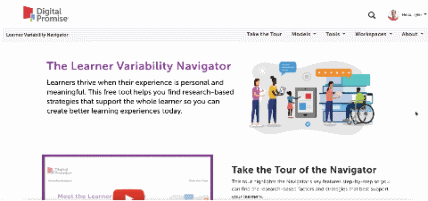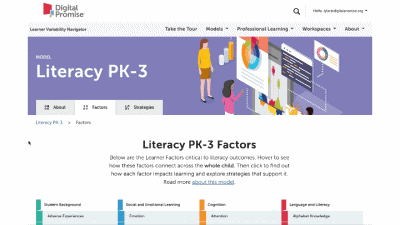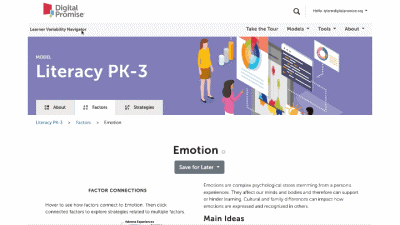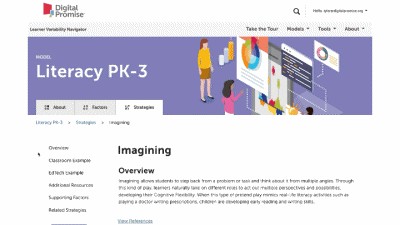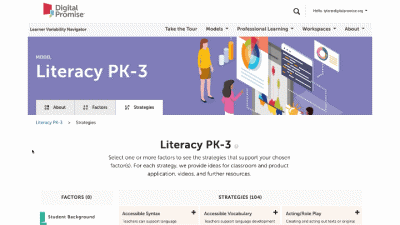Digital Promise Signature Workspace
Critical Literacy for Adult Learners
Critical thinking and criticality are essential skills for all learners. Learn more about how you can foster those skills.
relevant Learner skills and Factors
Composition is the ability to express ideas and information through writing.
Children develop the skills to present arguments and persuade others early, with skills increasing with Verbal Reasoning skills.
Critical Literacy is the ability to identify purposes, motives, and potential biases of a particular text to enhance overall comprehension and critical thinking.
The trauma that comes from experiencing adversity releases stress hormones that can lead to changes in the body and brain.
Metacognition is the ability to think about our internal cognitive processes, or to “think about thinking”.
Many stereotypes exist about the academic performance of learners based on categories such as their race, gender, or age.
strategies for Critical thinking, diverse & complex reading and writing models
Literacy 7-12
When teachers provide students with model texts for their writing, they learn to identify effective elements to incorporate into their own writing.
Literacy 7-12
Sentence frames or stems provide language support for students' writing and participation in academic discussions.
Literacy 7-12
Providing multiple texts on the same topic or theme allows students to interact with multiple perspectives and develop their critical thinking skills.
Literacy 7-12
Selecting culturally responsive reading materials, including multicultural and diverse texts, is critical for supporting all students.
Literacy 7-12
By observing, rereading, and closely analyzing published writing, students see examples and learn the strategies of good writing that they can integrate into their own Composition.
Literacy 7-12
Explicitly teaching strategies for planning, writing, and revising texts improves students' writing quality.
Literacy 7-12
Providing guiding prompts and questions for students to use when reading or participating in discussions deepens their understanding of texts and gives them space to question and grapple with issues of power, justice, and equity.
Adult learner
Instruction and training presented in multiple formats allows learners to activate different cognitive skills and Background Knowledge that are necessary to remember procedural and content information.
Literacy 7-12
Checklists and rubrics help students understand expectations as they navigate more complex tasks and assignments.
strategies for Authenticity
Literacy 7-12
When students write from a non-dominant or marginalized perspective, they consider and give voice to points of view that are often missing.
Literacy 7-12
When peers are able to work together to plan, draft, edit, and revise during the Composition process, their writing quality improves.
Literacy 7-12
For adolescent learners, the Composition process can become more robust, as learners begin to express ideas through multiple media, which includes visual, audio, and digital production.
Literacy 7-12
Increasing how much and how frequently students write improves both their writing quality and content knowledge.
Adult learner
When preparing for and executing a debate, learners analyze, form, and express verbal arguments, fostering their critical thinking skills, an essential component of Problem Solving.
Adult learner
When adults can connect and communicate with authentic audiences about their interests and values, learning becomes more personally meaningful and relevant.
strategies for Feedback, reflection & Metacognition
Literacy 7-12
Writing conferences allow students to fully immerse, share, reflect, and receive feedback during the writing process, promoting Motivation for continuing the sometimes lengthy revision process that occurs in the upper grades.
Literacy 7-12
Providing constructive feedback supports students' writing development by letting them know how to improve their writing.
Adult learner
Setting overall goals with actionable steps for achievement can help learners feel more confident in their abilities and help minimize procrastination-related behaviors.
Adult learner
Journaling allows learners to reflect on their thinking and feelings, process their learning, and connect new information to what they know and their practical experiences.
Adult learner
When adults are aware that learning involves effort, mistakes, reflection, and refinement of strategies, they are more resilient when they struggle.
Adult learner
Reflection can take place throughout learning, supporting critical thinking and Problem Solving skills when learners actively question assumptions, and after learning experiences to support Metacognition.

